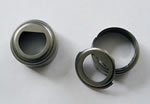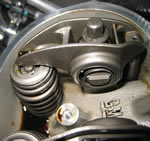Ruthless Pursuit of Power: The Mystique of the C6 Corvette LS7 Engine - Page 17 of 26
Ruthless Pursuit of Power: Lucky Seven Edition: The Mystique of the 7-Liter, 7000-RPM, LS7 - Page 17 of 26
 |
 |
by Hib Halverson
© May 2013— Updated: November 2014
No use without permission, All Rights Reserved
Bill Nichols' trick exhaust manifolds, the last block changes Muscaro talks about and a few other little tweaks saw final development LS7s meet the 500-hp goal senior management set almost two years before. GM had decided the LS7 would be certified using the Society of Automotive Engineers (SAE) then-new Standard J2723 "witness test". The SAE Standard to which the dyno test data is corrected had not changed--it was still J1349. What's different is: for a manufacturer to say an engine is "SAE-certified" requires that manufacturer test the engine in an ISO9000/9002-approved dynamometer testing facility and that the testing be witnessed by persons approved by the SAE. On 14 March, 2005, the J2723 testing was done and the engine produced 505 SAE net horsepower. A little over three weeks later on, 10 April, the LS7 was the first engine to ever have its power output certified to the SAE J2723 standard.
"When we ran the SAE advertised power witness test," Dave Muscaro told us, "we attained the now famous 505 hp level. But as the years go by, and the myth grows, the truth is: we actually were a bit unlucky on the witness test as we had engines with power levels higher than the 505 mark."
At the CAC, we can't help but wondering what that last statement means. Were the LS7s making 505-hp SAE net on the low-end of the pool of development engines and in the minority? Were most LS7s, when new, just a little more powerful? We're just askin'...
We let Dave Muscaro have the final word on the LS7 development. "Working in GM like we do, we work as a team. We don't 'win individually' nor do we 'lose' individually. Rather, when we create a successful production engine program, like the LS7, the whole team has reason to celebrate. Was I glad to be a part of it? You bet! I worked with many great engineers and I sweat the details on each part of the engine with each of them. I learned from them how to make each of their parts great and, when we put them all together, we had the LS7. From airflow and CNC'd ports to all the lube challenges high g-forces bring, to offset rocker arms and titanium valves/rods, to a very large throttle body and a forged crank--we all sweat many little details. So in the end, I consider myself very fortunate to have worked with all these great engineers who helped create the LS7 engine."
Durability
Every engine manufacturer does reliability and durability testing. "Reliability" is the quality of being consistent in performance, i.e.:, not failing. "Durability" is the quality of being able to withstand wear, i.e.: being reliable for a long period of time in service.
John Rydzewski and Jim Hicks touched on the reliability of individual parts such as titanium rods and intake valves during the discussions we had with them. Once the entire engine reaches a near-production form, its durability testing begins. Back in the old days--say the late-'80s when the famed LT5 was developed--some of the testing was on the dynamometer, but a lot of it was in cars on the road and on test tracks. In recent years, with advances in dynamometer technology and with the application of computer controls, more of the testing is done in dyno cells fitted with equipment which can alter the engine's attitude to simulate various acceleration, corning and braking loads. Even with all this advanced dyno testing ability, GM still track tests engines in cars as a final validation of the engine's performance, reliability and durability.
During the cylinder head discussion, Dennis Gerdeman, talked about durability testing.
"We had a durability schedule that we were running," Gerdeman said. "They call it the 24-hour track schedule. It was kind of our benchmark as we were going through the final validation of the hardware, from the whole-engine perspective. They ran a lot of these 24-hour track schedules, so we got quick overnight results. It was a very strenuous test. They did run the cars on the track, but most of (the durability testing) was on engine dynos. We could validate any corrections we were making to any of the hardware components--not necessarily to the cylinder head, but to valve train related pieces and all the other mechanicals--pistons, cams and so forth."
Another standard GM Powertrain torture test to which the LS7 was subjected is a 300-hour dyno test at wide-open throttle with the load varied such that the engine goes back and forth between peak torque (4800-RPM) and peak power (6300-RPM) in 125 RPM increments. The LS7 also was brutalized with a "thermal shock test" which runs engine coolant ranging between -40°F (burr) to about 250°F (ouch!) through the engine while it's running.
Oops...In Spite of Best Laid Plans
In any car company's manufacturing process, a weak link can be parts suppliers. Not only General Motors but Ford, Toyota and every other car company has to deal with this situation. An engine manufacturer can have the world's best design, but all it takes to turn the situation FUBAR is one supplier's quality control to slip. Worse yet: if it's problems downstream in a supply chain-say the quality control of a source of materials (such as: a bearing maker) to a manufacturer which supplies parts (such as: rocker arms) to a final assembly facility (such as: GM's Performance Build Center)-the result can be quite unfortunate. Sadly, this happened twice in the LS7s life.
The first problem developed in a relatively small number of LS7s assembled during the first half of 2007. In late 2006, about 1500 rocker arms were manufactured by GM's rocker arm supplier using defective needle bearing assemblies made by that supplier's source for bearings. The end caps of these defective bearings could fracture at the radius between the side and the top of the cap. When that happened, the top, or pieces of the top, separated from the rocker arm. Once the cap failed, bearing needles exited the rocker. The cap fragments and/or needles would either lodge in cavities in the top of the head or be flushed through the oil return holes in the head and down into the oil pan. The oil pickup screen is too fine for these pieces to get sucked into the oil pump, so they would reside in the oil pan until the next time the oil pan drain plug was removed.
In some cases, the problem can be worse than just needles in the drain oil. If a full "bearing load" of 33 needles gets loose, significant play develops between the rocker fulcrum and the rocker body with engine operation quite noisy. If the engine runs for an extended period with such a large large amount of play in the rocker arm, damage to the valve, the valve locks, the retainer or all three may occur. Damage to those parts may allow a valve to drop into the cylinder. The result of that is catastrophic failure of the engine.
A small amount of LS7s, assembled between early January and late July 2007, were had these defective rockers. Most have been repaired under warranty, but even today, there are occasional reports of '07 LS7s with needles in their drain oil. With '07s now out of warranty, repair of an LS7 with failed rockers will come out of the owner's pocket. If you find rocker roller needles in drain oil, immediately inspect all 16 rocker arms and make repairs as necessary because, if you don't address that problem quickly, dealing with it later may cost you far more.
 |
 |



